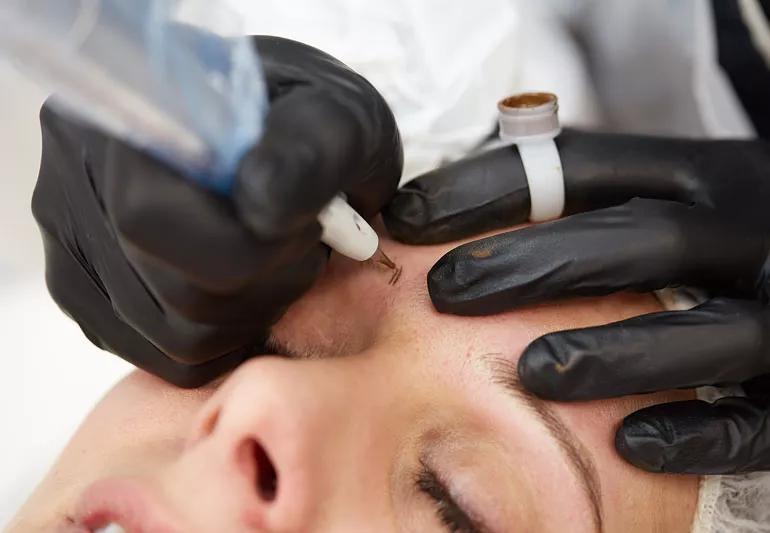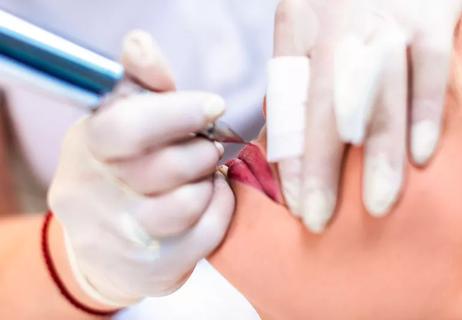What you need to know about micropigmentation straight from a cosmetic dermatologist

Maybe you have unsteady hands or poor eyesight that make it difficult for you to apply eyeliner, lipstick or other cosmetics. Perhaps you have medical reasons to add pigmentation to certain areas of your body. Or perhaps you lead a busy life with little time to do your makeup, or can’t find makeup that lasts long enough on your skin.
Advertisement
Cleveland Clinic is a non-profit academic medical center. Advertising on our site helps support our mission. We do not endorse non-Cleveland Clinic products or services. Policy
If any of these are true, you may have considered looking into permanent makeup as a solution. But you probably wonder exactly how it works, or if permanent makeup is even safe. Many also question if permanent eyeliner, for example, can be removed once it’s applied.
When considering whether or not this type of procedure is worth it, it’s usually the word “permanent” that creates pause. Interestingly this can be the best (or potentially the worst) aspect of the procedure depending on certain factors.
We asked cosmetic dermatologist Shilpi Khetarpal, MD, to offer her insight to see if permanent pigmentation is right for you.
Permanent makeup, also called a cosmetic tattoo or micropigmentation, is done with the use of a pen containing iron oxide that tattoos the skin and to create the look of makeup.
A tattoo can mimic eyeliner or lipstick, or it can darken and create the look of thicker eyebrows. It can also camouflage scars and help with the look of an uneven hairline.
“Certainly people with physical limitations or medical conditions may seek out this procedure, but anyone can have it done,” Dr. Khetarpal says.
In particular people with cataracts, arthritis, multiple sclerosis, Parkinson’s disease or those who have suffered from a stroke may find this procedure appealing. It can help them look their best while avoiding the physical challenges of applying makeup.
Advertisement
It can offer an option to those who have allergies to traditional makeup. It also offers a cosmetic solution for patients experiencing certain medical conditions to restore the skin to pigmentation, like after breast surgery or hair loss due to some illnesses.
The most important thing people should know is that permanent makeup is not easily removed — and there are risks involved, Dr. Khetarpal says.
“Removing tattoo pigment can be very difficult depending on the color. It’s a long, painful, expensive process to remove the ink — and sometimes the ink can’t be entirely removed,” she says.
On the other hand, while this makeup never washes off entirely, it will usually fade over time as skin cells are constantly being replaced. So you may need to revisit it again in time.
While most of the people doing the procedure are aestheticians or tattoo artists, you can also search online for physicians performing micropigmentation in your area.
Dr. Khetarpal says to do your research and ask:
“Make sure they use medical-grade sterilization and high quality ink. Also, look for someone who gives natural results and ask about their follow-up care policy,” Dr. Khetarpal says.
Be sure you know your skin type and have a consultation before scheduling any procedure. Ask for their credentials or certification. Is the office clean? Also consider after visiting, talking and observing — do you feel confident going forward?
You can request a tour of the facilities including the room where the procedure will take place. Make sure to confirm whether you’ll need anesthesia (usually local).
There’s always a risk of infection when needles are involved. This is especially true if the needles used haven’t been properly sterilized.
“Your body can react to the foreign ink particles and form areas of inflamed tissue,” Dr. Khetarpal says. “If you’re prone to them the tattoo process also can leave keloid scars.”
People also can be allergic to a particular color or type of tattoo ink.
“Once you have a reaction it can be very difficult to treat, but this can be avoided by doing a test area behind the ear to see if there’s a reaction,” Dr. Khetarpal says.
Other possible complications include bleeding, crusting, swelling, loss of eyelashes, severe eyelid injury and ectropion (which occurs when the eyelid is turned away from the eyeball).
According to the U.S. Food and Drug Administration pigments also can interfere with cranial MRI scans by affecting the quality of the images. Rarely, MRI scans can cause swelling or burning in the area of a tattoo.
Advertisement
The amount varies by the practitioner and the complexity of the work you’re requesting and because it’s cosmetic, it’s likely not covered by insurance.
Focus first on finding reputable places before you factor in cost. Also strongly consider to delay or forgo if you don’t find a good fit.
While the promise of permanent makeup can be appealing, you should think carefully about this decision, especially if you’re a younger person. Remember that areas on the face (such as the eyes, eyebrows and lips) change over time with age.
“Beauty trends also change with time. Full lips and thick eyebrows are flooding social media these days, but this may not be the case five or 10 years from now,” Dr. Khetarpal says. “Always start with a minimalistic approach to look natural — because less is more.”
It’s also very difficult to mimic the appearance of eyebrow hair with tattoo ink, she adds.
You could need multiple treatments, so make sure you talk about this with your practitioner. You also may need to touch up the tattoo as pigment fades with time.
“There’s a reason micropigmentation is considered permanent,” Dr. Khetarpal says. “And when it comes to the face you put forward each day to the world, you want to make sure you’ve fully and carefully considered the commitment you’re really making.”
Advertisement
Advertisement
Learn more about our editorial process.
Advertisement

The semi-permanent tattoo can enhance your lip color and give the illusion of fullness

Early attention to skin wounds can help minimize their appearance later

Several conditions, like vitiligo and fungal infection, can cause a loss of pigmentation, leading to white spots or patches on your skin

Moisturizing, running a humidifier and adjusting your showers may help keep itchiness and irritation at bay

‘Zit stickers’ can help heal a new or popped pimple, but they’re limited when it comes to managing acne

Glycolic acid benefits skin tone, texture and pigmentation by exfoliating dead skin

At-home treatments and lifestyle changes may help ease the symptoms and improve the appearance of varicose veins — but they aren’t a cure

Scalp cancers can occur because of long-term sun exposure

Start having sex about 72 hours before ovulation, then at least every other day during your fertile window

Attachment theory suggests that your earliest relationships shape connections throughout your life

It isn’t a recognized mental health disorder, but research shows that problematic social media use can negatively affect your mental health, self-esteem and sleep